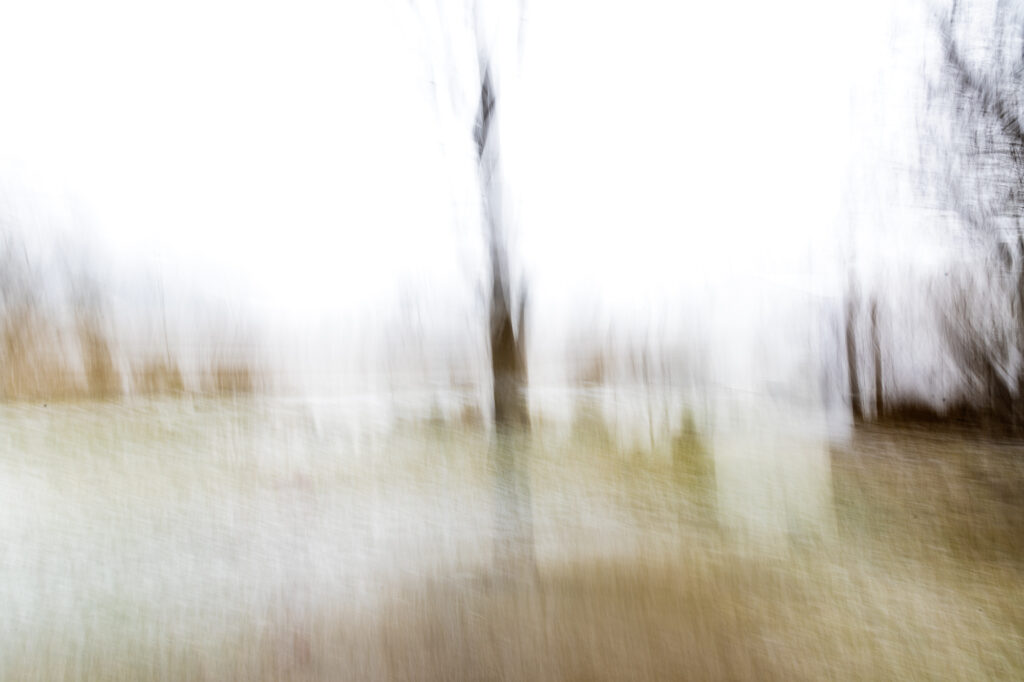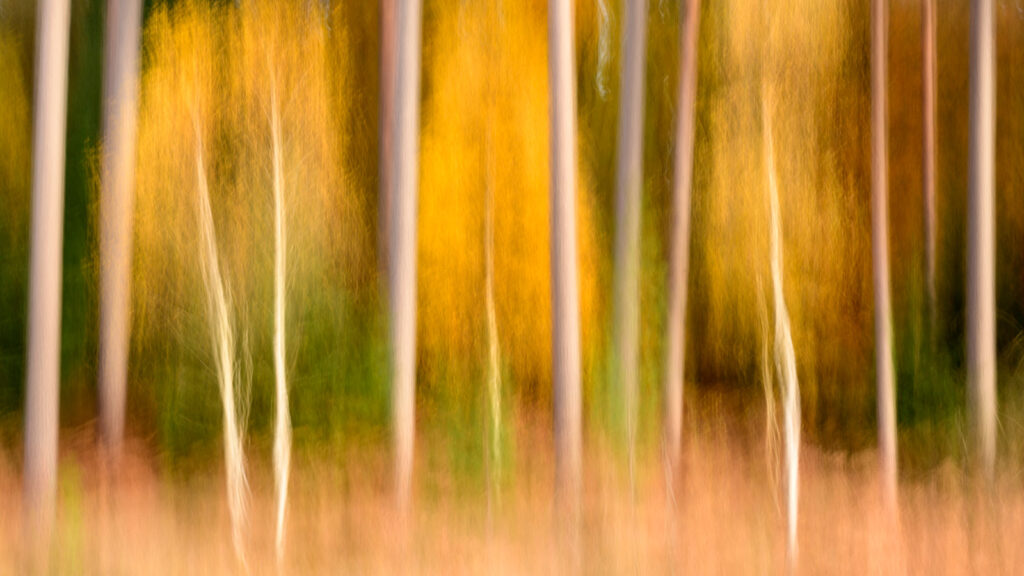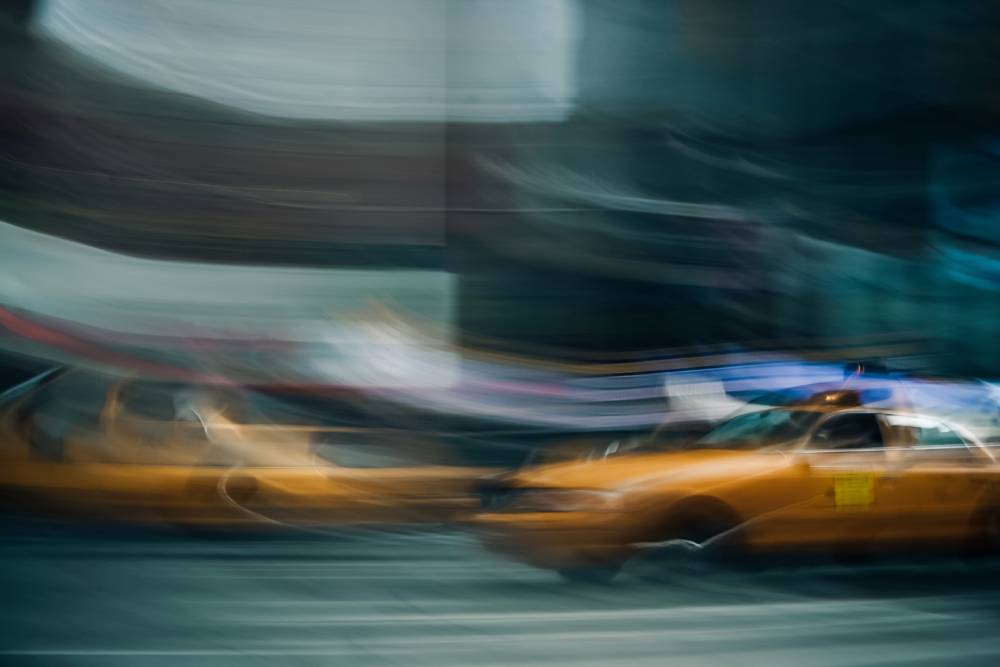| SPECIAL INTEREST: ART |
Story & Photography by: Hawk Buckman
In the world of photography—where sharpness and precision are often prized above all else—there exists a rebellious technique that throws convention to the wind. Intentional Camera Movement, or ICM, is an approach that embraces blur, motion, and abstraction, transforming everyday scenes into painterly works of art. Instead of freezing a moment in time, ICM captures the feeling of a moment—fluid, unpredictable, and alive.
| WHAT IS INTENTIONAL CAMERA MOVEMENT?
At its core, ICM is exactly what the name suggests: moving the camera deliberately during a long exposure. By shifting, panning, tilting, rotating, or even jiggling the camera while the shutter is open, photographers produce streaks of color, ghostly shapes, and impressionistic renderings of their subjects. Trees become brushstrokes, city lights turn into ribbons, and landscapes dissolve into dreamlike swaths of tone.

The technique relies on slower shutter speeds—anywhere from 1/10 of a second to several seconds—allowing enough time for motion to be recorded. The results can be unpredictable, and that’s part of the appeal. ICM blurs the line between photography and painting, pushing the boundaries of what a camera can do.
Though the term Intentional Camera Movement is relatively modern—popularized in the late 20th and early 21st centuries—the concept has roots stretching back to the early days of photography. Pictorialist photographers in the late 1800s and early 1900s, such as Alfred Stieglitz and Edward Steichen, experimented with soft focus and motion to mimic the qualities of fine art painting. Their goal was to elevate photography beyond mere documentation and into the realm of creative expression.
By the 1950s and ’60s, photographers like Ernst Haas began to embrace color and motion as central creative tools, producing vibrant, blurred images that influenced a generation of visual artists. However, it wasn’t until the rise of digital photography in the early 2000s—when experimentation became less costly—that ICM began to flourish among hobbyists and professionals alike.
ICM appeals to photographers for several reasons:
- Creative Freedom – Without the constraints of perfect focus and static compositions, the photographer becomes a visual composer, shaping motion and light in ways that mimic brush and ink.
- Emotional Expression – Because ICM prioritizes mood over detail, it can convey feelings—serenity, chaos, nostalgia—in ways a sharp, still image may not.
- Uniqueness – Each image is a one-off creation; even the same subject shot twice will yield different results, making ICM an inherently personal and distinctive art form.
- Escape from Literalism – In a world saturated with high-resolution, literal imagery, ICM offers viewers something more interpretive, sparking curiosity and conversation.

While there’s no strict rulebook for ICM, several approaches are common:
- Panning – Moving the camera horizontally to follow a subject or to create sweeping motion across a landscape.
- Vertical Sweeps – Tilting the camera up or down, often used with trees or architectural lines.
- Rotation – Twisting the camera during exposure for circular motion effects.
- Zoom Pulls – Adjusting the zoom ring while the shutter is open for dynamic, radiating blur.
Photographers often pair ICM with neutral density filters to allow longer exposures in bright conditions, giving more time for controlled motion.
In recent years, ICM has become increasingly popular in fine art photography exhibitions, print sales, and online artist communities. Social media platforms have amplified the technique’s reach, with hashtags like #ICMPhotography connecting thousands of photographers who share tips, inspiration, and their latest experiments. Workshops dedicated entirely to ICM are now commonplace, reflecting its acceptance as a legitimate art form rather than a “mistake” in camera handling.

Collectors and galleries are also taking note, appreciating the painterly qualities of ICM prints that often command a timeless, almost meditative presence. In an era when artificial intelligence can mimic reality to an uncanny degree, human-made abstraction like ICM feels refreshingly authentic.
Perhaps the greatest strength of ICM is its ability to blur boundaries—not just in the images themselves, but in the dialogue between photography and other arts. It appeals equally to photographers seeking freedom from technical rigidity and to painters who find kinship in its gestural strokes of light and shadow.
In the end, Intentional Camera Movement is more than just a technique—it’s an act of liberation. It’s about letting go of control, embracing imperfection, and creating something that speaks in whispers rather than shouts. For the photographer willing to set aside the safety of stillness, ICM offers a journey into the fluid poetry of motion.
Whether you’re a complete beginner with a camera, exploring a far-off destination, relaxing in your own backyard, or simply taking a stroll through the neighborhood, you can experiment with Intentional Camera Movement. ICM doesn’t require exotic locations, expensive gear, or years of experience—only a willingness to play with shutter speed and embrace the unexpected. The beauty of this technique is that it transforms the ordinary into something extraordinary; a row of trees, a patch of flowers, or the dappled light on a sidewalk can become a swirling, abstract masterpiece with just a slight movement of the camera during exposure.
| REFERENCES
- Wikipedia – Intentional Camera Movement: Defines ICM as the deliberate movement of the camera during exposure to create artistic blur, textures, and streaks, emphasizing motion as a compositional element. Provides technical notes on shutter speeds and use of filters. :contentReference[oaicite:1]{index=1}
- Number Analytics – Mastering Intentional Camera Movement: Highlights Ernst Haas as a pioneering ICM photographer whose abstract, impressionistic cityscape images helped legitimize the technique as an artistic form. :contentReference[oaicite:2]{index=2}
- Alan Brown Photography Blog – Defining the New ICM: Notes the roots of ICM in mid-20th century experimentation by artists like Ernst Haas, blending camera movement with longer exposures despite film-era limitations. :contentReference[oaicite:3]{index=3}
- Great Big Photography World – Intentional Camera Movement: A Complete Guide: Traces ICM’s lineage to Impressionist painting and highlights Haas’s 1950s slow-shutter experiments with matadors, as well as modern practitioners like Erik Malm and Charlotte Bellamy. :contentReference[oaicite:4]{index=4}
- Nature TTL – An Introduction to Intentional Camera Movement: Introduces prominent contemporary UK ICM artists such as Valda Bailey, Chris Friel, and Doug Chinnery, renowned for their abstract, creative approaches. :contentReference[oaicite:5]{index=5}
- Iris28 – A Complete Guide to Digital ICM: Mentions early adopters Ernst Haas (circa 1956) and Kōtarō Tanaka, who experimented with camera movement and fireworks to create colored light auras. Also references modern contributors like Erik Malm and Charlotte Bellamy. :contentReference[oaicite:6]{index=6}
- Franklin Arts – Intentional Camera Movement: Notes that the term “ICM” was coined in the 1960s and that the exact origins are unclear, but suggests influences from Pictorialism—a late-19th century artistic photography movement aiming to emulate painting styles. :contentReference[oaicite:7]{index=7}














